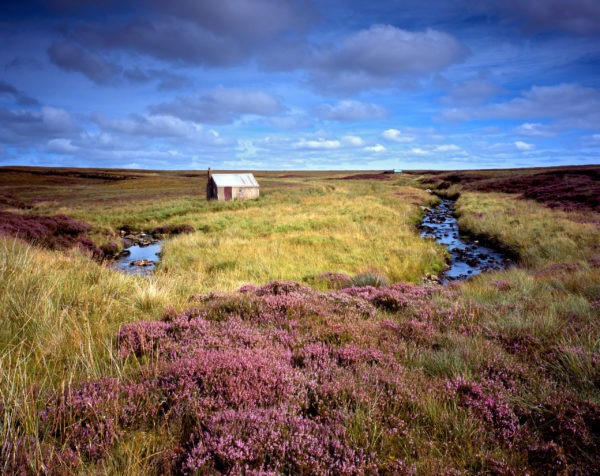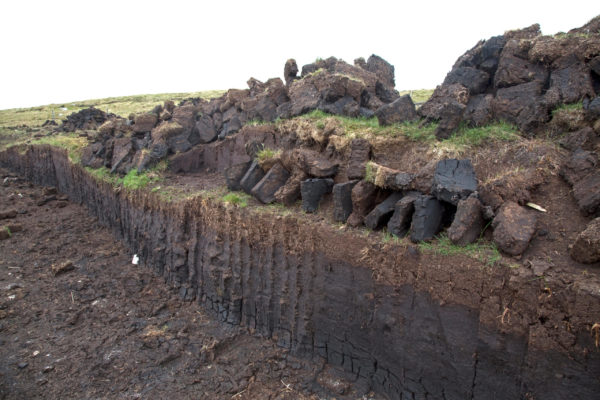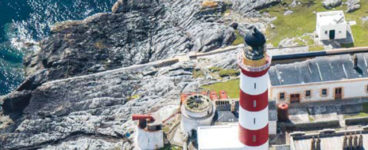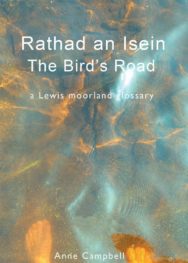‘fàd, a single, cut peat’
As languages decline in usage, we also lose the understanding of the world around us. In many cases, we lose the minute details of landscape, words in the dialect of a tiny area, words for very small localities and features, and words for specific items that are used much less – their stories and pasts begin to disappear.
Rathad an Isein, compiled by Anne Campbell in collaboration with Finlay Macleod, Donald Morrison and Catriona Campbell, is a little artist’s book in two sections which recalls, records and remembers words – the first relates to the Isle of Lewis moorland in general, the second section to the peat-cutting terminology of the west side of Lewis, and the northerly part of the island, Ness.
Rathad an Isein/The Bird’s Road: A Lewis Moorland glossary
Compiled by Anne Campbell
Published by Faram

earball a’ phuill, the tail-end of the peat bank (FM).
fàd, a single, cut peat (KC).
fàd a’ chaorain, lowest and usually third level of peat bank (DM). See also in caoran.
fàd a’ ghàrraidh, the second level of a peat bank (DM). See also an dàrna fàd.
fàd fuart, ‘cold peat’. A peat left on the cut surface of the bank because the person on the peat iron is cutting too fast for the person throwing the peat (Maclean et al, 1998). See also banntrach.
fòid, depth of peat bank measured in number of peats that can be cut from top of bank to hard. Thus poll aon fòid, poll dà fhòid, poll thri fòid, for a bank one, two, three peats deep (DM).
gairsearch, small bank of fibrous peat situated close to the house, hence easier to reach (MS).
gàrradh, peats placed on top of each other on the edge of the druim in such a way as to let the air circulate through them, forming a low wall. The gàrradh can be built in different styles (KC).
grabhag, a small insignificant peatbank (MacIlleathainn & NicPhàil, 2005). See also pollag.
làdach mòine, a full trailer-load of peats, the sides of which are built up with stèidheadh (KC).
luath dhearg, red peat ash, obtained from burning mòine dhubh. This can be used as a keel mark on sheep (KC).
luath na mònach, peat ash (FM).

mòine, peat, once it is processed (cut and dried) (KC).
mòine bhàn, light, younger, upper peat. Great peat (FM).
mòine chòsach, spongy peat (FM). See also calcas.
mòine chruaidh, hard peat (FM).
mòine dhubh, heavy, dark, older, deeper peats; black peats (FM).
mòine fhliuch, soft peats (FM).
mòine thioram, dry, hard peats (FM).
poll mònach, peat bank (KC).
pollag, a small insignificant peat bank (MacIlleathainn & NicPhàil, 2005). See also grabhag.
rathad an isein, ‘the bird’s road’. The narrow gap left on top of the bank between the gàrradh and the cut edge of the bank (MacIlleathainn & NicPhàil, 2005).
riasg, natural, wet, uncut peat (KC).
rùdhan, group of four drying peats, with three standing on end and one set on top (FM).
rùsg, turf covering peat bank (FM).
sgiath-dhubh, the ragged bit left on the end of a peat which has been cut longer than the length of the blade of the past iron (Maclean et al, 1998)
sgiobadh, ‘the crew’ who went to the peats, giving mutual help with the work (DM).
smùr mònach, peat dross (DM).
stèidheadh, construction of the peat stack in such a way as to support the sides and shed rain. Various patterns are used in the wall of the stage; e.g. sloping wall, flat wall, herringbone. Also used when taking peats home in order to build high loads which will not move in transit (DM).
tairsgeir, peat iron. Tool for cutting peats. Part of the tairsgeir: a’ chas (FM)/a’ làmh (Maclean et al, 1998), wooden shaft; a’ smeachan, the step for the right foot; a’ chrò (FM)/a’ chnò (Maclean et al, 1998), the heel, the width of the peat; an iarann (DM), a’ sgian (FM), the blade; bàrr na sgine, point of the blade; faobhar na sgine, edge of the blade; na h-ailean, socket in iron part into which the handle and step are inserted (Maclean et al, 1998).
Rathad an Isein/The Bird’s Road: A Lewis Moorland glossary compiled by Anne Campbell is published by Faram, priced £4.00.
Photo credits, in order:
- CF43XH Old crofter’s huts on wild moorland on the Isle of Lewis. Credit – Loop Images Ltd / AlamyStock Photo
- E6M6XH Peat cutting Isle of Lewis Outer Hebrides Scotland. Credit – Mark Boulton / AlamyStock Photo
ALSO IN THIS ISSUE

 A Guide to Climate Change Impacts on Scotland’s Historic Environment
A Guide to Climate Change Impacts on Scotland’s Historic Environment
‘The hottest day of the year is now on average 0.8 centigrade hotter.’

 Of Stone and Sky
Of Stone and Sky
‘They did not speak their names or venture the reasons for their departures for fear of what that mi …













